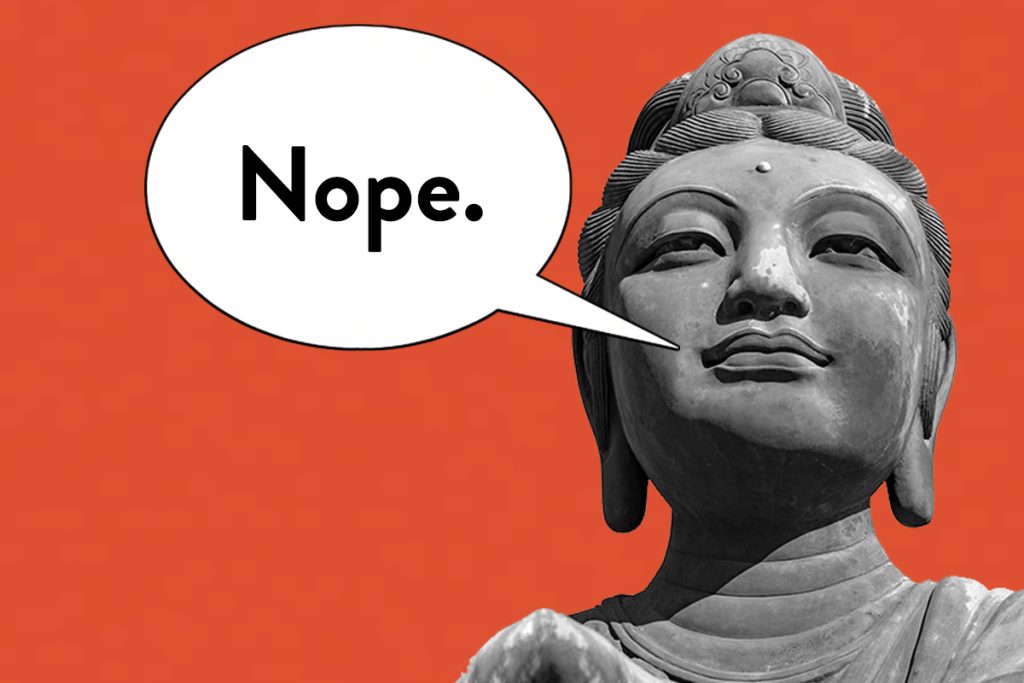Bodhipaksa is an author and a teacher with the Triratna Buddhist Community. Since 2003, he has debunked some of the most popular quotes misattributed to the Buddha (see his website). His most recent book, I Can’t Believe It’s Not Buddha! What Fake Buddha Quotes Can Teach Us about Buddhism, uses these wrongly ascribed aphorisms as a jumping-off point to introduce us to the Buddha’s actual teachings.
Q&A WITH BODHIPAKSA:
What’s the most egregious fake Buddha quote you have ever encountered?
Unfortunately I’m rather spoiled for choice, but on stylistic grounds I’d pick “Ennui has made more gamblers than avarice, more drunkards than thirst, and perhaps as many suicides as despair.” This is too literary to be from any of the early Buddhist scriptures, which tend to be clunky and repetitive in style as a result of both the peculiarities of Pali and Sanskrit grammar and the fact that the teachings were originally passed down orally. This quote is actually from an 1820 book by an English cleric, the Rev. Charles Caleb Colton, who also coined the phrase “Imitation is the sincerest form of flattery.”
How do you track down the origins of fake Buddha quotes? How long does it take?
I rely mainly on Google Books and to a lesser extent on archive.org. My online readers have helped me, too. As for time, I’ll probably never find a definitive source for every misattributed quote, but when I have, it’s taken anything from a few minutes to many hours.
How can we avoid falling for fake Buddha quotes ourselves?
I’d encourage all Buddhist practitioners to develop a familiarity with the early scriptures. If we’re familiar with the style and content of those bodies of work, then we’re less likely to be fooled.
The Buddha taught a coherent path to awakening, so although individual quotes may be uplifting, it’s far more beneficial to read the actual suttas or sutras. If you don’t know where to get started, I’d recommend Bhikkhu Bodhi’s In the Buddha’s Words, which makes the scriptures more accessible by organizing the material in themed chapters.
If you want to go even deeper, read some of the scholarship—for example, by Richard Gombrich, Bhikkhu Analayo, and Bhikkhu Sujato. This helps remind us that the Buddhist scriptures were originally living, evolving documents and that we can’t be certain that any given statement they contain was made by the Buddha. The scriptures have to be read critically, too!
How can Buddhist teachings help us skillfully navigate this “post-truth” environment of misinformation, rampant conspiracy theories, and online echo chambers?
Yikes! Can I have the whole magazine? The Buddha seems to have been a proponent of radical honesty. He says in the scriptures, “There is no evil that cannot be done by a person who deliberately lies.” I’d suggest starting there: with honesty. Before passing on a news story or a rumor, let’s ask ourselves if we know it is accurate. Other good practices would be not exaggerating, not distorting our opponents’ viewpoints in order to set up easily dismissed “straw men,” and applying the same standards to “your side” as you do to “the other side.”
TEST YOUR KNOWLEDGE
Real or Fake?
Take this short quiz (or the interactive version above) and find out if you know the difference between the Buddha’s words and a dharma dud.
1.
“Do not dwell in the past, do not dream of the future, concentrate the mind on the present moment.”
Verdict: Fake
Original Source: The Teaching of Buddha, “a sort of Buddhist Gideon Bible of Buddhist scriptures and modern commentary” found in Japanese (and some American) hotels
2.
“People with opinions just go around bothering each other.”
Verdict: Real, though Bodhipaksa prefers the translation: “Those who cling to perceptions and views / Wander the world offending people.”
Original Source: To Magandiya in the Sutta Nipata, one of the oldest collections of texts in the Pali canon
3.
“Like someone pointing to treasure is the wise person who sees your faults and points them out. Associate with such a sage.”
Verdict: Real
Original Source: Dhammapada verse 76, translated by Gil Fronsdal (2006)
4.
“Holding on to anger is like drinking poison and expecting the other person to die.”
Verdict: Fake
Original Source: The Sermon on the Mount (1934) by Emmet Fox, a New York City–based New Thought spiritual teacher
5.
“Life has no meaning in itself but it is itself an opportunity to make it meaningful.”
Verdict: Fake
Original Source: Dang Dang Doko Dang (1977) by Osho, also known as Bhagwan Shree Rajneesh, a controversial 20th-century spiritual leader
6.
“We are what we think. All that we are arises with our thoughts. With our thoughts we make the world.”
Verdict: Fake
Original Source: Thomas Byrom’s (mis)translation of the Dhammapada (1976)
♦
Quiz answers adapted from I Can’t Believe It’s Not Buddha! What Fake Buddha Quotes Can Teach Us about Buddhism by Bodhipaksa © 2018 and fakebuddhaquotes.com. Excerpted with permission of Parallax Press and Bodhipaksa.
Thank you for subscribing to Tricycle! As a nonprofit, we depend on readers like you to keep Buddhist teachings and practices widely available.
